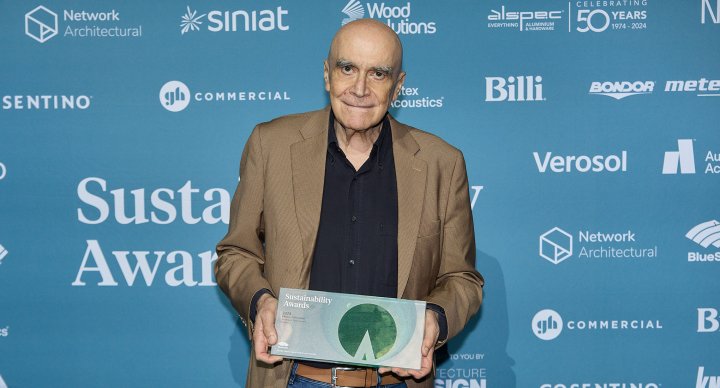
BlueScope congratulates Professor Mattheos Santamouris, Scientia Distinguished Professor of High-Performance Architecture at UNSW Sydney, on receiving the Lifetime Achievement Award at the 2024 Sustainability Awards. Recognised for his research in energy conservation and heat-mitigation strategies to curb urban overheating, his work has made a significant impact on sustainable architecture and the built environment.
The Sustainability Awards are Australia’s longest-running program dedicated to acknowledging excellence in sustainable design and architecture. BlueScope is proud to once again have sponsored the Lifetime Achievement Award category.
In addition to his role at UNSW Sydney, where he is the Anita Lawrence Professor of High-Performance Architecture, Professor Santamouris has held academic positions at leading institutions worldwide. He is a past professor at the University of Athens in Greece and a visiting professor at institutions including the Cyprus Institute, Metropolitan University of London, Tokyo Polytechnic University, and the National University of Singapore among others. He also served as President of the Center for Renewable Energy Sources and Energy Savings, Greece.
Professor Santamouris has spent over 30 years leading research into urban overheating and heat-mitigation technologies, driving advancements that inform policy, urban planning, and building design. He has coordinated numerous international research programs and provided expert reviews for research projects across 15 countries, including Australia, the United States, the United Kingdom, France, Germany, Canada, and Sweden. As a world-leading researcher in sustainable architecture, Professor Santamouris has published nearly 290 peer-reviewed papers, authored and edited 15 books, and serves as editor-in-chief of Energy and Buildings and associate editor of Solar Energy Journal, in addition to holding editorial roles with several other publications.
Cool roof technology
A key focus of Professor Santamouris’ research is cool roof technology - a ‘cool roof’ is made from materials designed to have high solar reflectance and thermal emittance, to help keep the roof surface temperature cooler in the sun. A roof surface that reflects sunlight and emits thermal infrared radiation stays cooler than a roof surface that absorbs sunlight and limits thermal infrared radiation. His studies show that implementation of cool roofs across major Australian cities could help reduce energy bills, lower indoor temperatures, and decrease urban heating. The research further found that energy consumption for cooling residential and commercial buildings could decrease by up to 40% if the whole of Sydney implemented cool roofs1, offering significant benefits for both energy efficiency and urban climate resilience.
“Professor Santamouris’ research has provided extensive evidence of the benefits of cool roofs in reducing the intensity of Urban Heat Islands and reducing energy demand in buildings,” said Philippa Stone, Sustainability Manager at BlueScope. “His work has demonstrated that adopting these technologies can significantly decrease energy consumption from cooling and help maintain thermal comfort.2
“At BlueScope, we recognise the importance of cool roofing solutions, which is why we offer 11 COLORBOND® steel cool roofing colours in our core colour range to support compliance with the National Construction Code energy efficiency provisions3 and mitigate the effects of Urban Heat Islands.”
BlueScope congratulates Professor Santamouris on this well-deserved recognition and values his contributions to heat mitigation and energy conservation. His pioneering research continues to shape urban cooling strategies and innovative solutions for reducing urban overheating and improving energy efficiency in the built environment.
More information
- To read more about Professor Santamouris’ credentials, publications, awards and research activities, visit www.unsw.edu.au/staff/mattheos-santamouris
- Want to know more about the benefits of cool roofing? Explore our detailed articles to learn more.
- See the core range of COLORBOND® steel cool roofing colours
- Reference: Are cool roofs the future for Australian cities? – University of New South Wales Newsroom
- Actual cool roofing performance, including potential energy savings and thermal comfort improvements, depends on a wide range of factors including roof colour, roof shape, level of insulation, type, location, shape, and function of the building, and the type and efficiency of heating and cooling systems.
- The eleven (11) cool roofing colours in the COLORBOND® steel core colour range all feature low Solar Absorptance (SA) values of less than or equal to 0.45. These colours meet the deemed-to-satisfy compliance for roof cladding material within the National Construction Code (NCC) Volume 1 Section J energy efficiency provisions.
